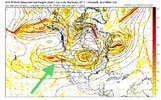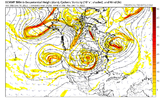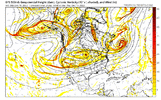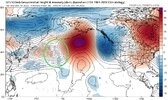iGRXY
Member
Oh yeah I agree. Currently there are caveats we can take away from the gfs but I trust it very little especially when the ensembles have not had its back. Obviously the nice little wound up low giving the deep south snow is fun to look at.At first glance it looks not great but this is air that’s still plenty cold enough to support some winter weather with the suppressed storm track and blocking over top .. and the gfs is certainly playing with that idea right now .. cold enough for a thumping of snow with a dynamic system. Still gfs is a bad model so this is just eye candy but I won’t budge on believing anything it says until CMC but more importantly the euro agrees with it
Yeah except it goes a lot further south than the one last year if I remember correctly. I’m surprised the snow is that far south.The 00z GFS looks very similar to that storm we tracked last year. Marginal temps that are reliant on the SE Canada Vortex.
Wintry - Winter 2021/2022 Model Archive
18z GFS 1/3 NC Event https://southernwx.com/community/threads/januworry.1019/page-82#post-502265southernwx.com
Try the 00z CMC 1/11/2022 run. This one was even closer.Yeah except it goes a lot further south than the one last year if I remember correctly. I’m surprised the snow is that far south.

It’s pretty embarrassing in this day and age. All of the technology we have at our fingertips.
CMC during the gfs fantasy storm. These models are a joke
Sent from my iPhone using Tapatalk




This is what I posted earlier. You can see it go back towards the Rockies, even on the surface maps!! Very bizarreI've looked at a lot of old winter storms from the past, and I can say with confidence that I've never seen one take this progression / path at 500mb that is shown on this 00z GFS run. The wave tracks from N California to Nebraska, makes a loopty-loop, extending back into Wyoming, then dives SE to Charleston. Highly unlikely to happen that way, but as the country song goes, "there's a first time for everything"
Anyway, as @ILMRoss alluded to earlier today, all of the models are struggling with this wacky, blocky pattern, not just the GFS. There's no better time than now to lean on the ensemble means...and even those aren't staying consistent

Thanks John. Just read thru it. A lot of times they don't add those types of interesting tidbits like they did in the old days....maybe this "Scott H" forecaster is one of the better ones to followIf worried about a warm up after this cold shot, read the CPC long range forecast discussion from earlier today. It notes the GFS is basically not very usable currently because it's improperly handling storms in relation to the -NAO/blocking pattern. That is causing it to have wildly varying results from run to run as it gets further into the extended. CPC said they aren't even using it in their longer range forecasts right now and instead are using the Euro/EPS.

If worried about a warm up after this cold shot, read the CPC long range forecast discussion from earlier today. It notes the GFS is basically not very usable currently because it's improperly handling storms in relation to the -NAO/blocking pattern. That is causing it to have wildly varying results from run to run as it gets further into the extended. CPC said they aren't even using it in their longer range forecasts right now and instead are using the Euro/EPS.
Give this one a try as well. It's the one that speaks about the GFS having issues and expects the cold air to continue into week 3, and that week 3 will be so BN that the week 4 will average out to BN even if there's warming in parts of the country as they expect the return of the -PNA. They note the -NAO is likely to continue, along with the -AO through the 4 week period.Thanks John. Just read thru it. A lot of times they don't add those types of interesting tidbits like they did in the old days....maybe this "Scott H" forecaster is one of the better ones to follow
Prognostic Discussion for 6 to 10 and 8 to 14 day outlooks
NWS Climate Prediction Center College Park, MD
300 PM EST Fri December 09 2022
8-14 DAY OUTLOOK FOR DEC 17 - 23 2022
During the week-2 period, models are in good agreement in persisting a 500-hPa
ridge across Alaska, but differ as to the strength and orientation. Farther to
the east, as the GEFS significantly weakens the ridge predicted over eastern
Canada relative to today's ECMWF and Canadian Ensemble Means. The increased
model uncertainty across the higher latitudes of North America results in high
forecast spread in the predicted strength of the AO, which in turn, increases
uncertainty in the overall pattern farther to the south over the CONUS. The
ECMWF ensemble mean solution maintains the strongest ridge over Alaska, thus,
reflects a correspondingly strong trough farther to the south near California.
Meanwhile, the Canadian ensemble maintains a strong trough across the eastern
CONUS, consistent with anomalous ridging forecast near Greenland. The GEFS
depicts near normal heights over most of the CONUS, with significant below
normal heights confined to the southwestern CONUS. Today’s week-2 manual height
blend favors the 00z ECMWF Ensemble Mean solution, based on considerations of
recent skill.
The official 8-14 day 500-hPa height blend consists of: 20% of Today's 6z GFS
Ensemble Mean centered on Day 11, 55% of Today's 0z European Ensemble Mean
centered on Day 11, and 25% of Today's 0z Canadian Ensemble Mean centered on
Day 11
FORECAST CONFIDENCE FOR THE 8-14 DAY PERIOD: About Average, 3 out of 5, due to
good agreement among models on an amplified pattern early in the period offset
by significantly increased model uncertainty by the end of week-2.
FORECASTER: Scott H

Thanks, good nuggets in there and well writtenGive this one a try as well. It's the one that speaks about the GFS having issues and expects the cold air to continue into week 3, and that week 3 will be so BN that the week 4 will average out to BN even if there's warming in parts of the country as they expect the return of the -PNA. They note the -NAO is likely to continue, along with the -AO through the 4 week period.
Climate Prediction Center - Week 3-4 Outlook
www.cpc.ncep.noaa.gov




I mean.. with how consistent the EURO is with the cold push, the GFS has been starting to get its act together for a stellar SE ridge.
Sent from my iPhone using Tapatalk
